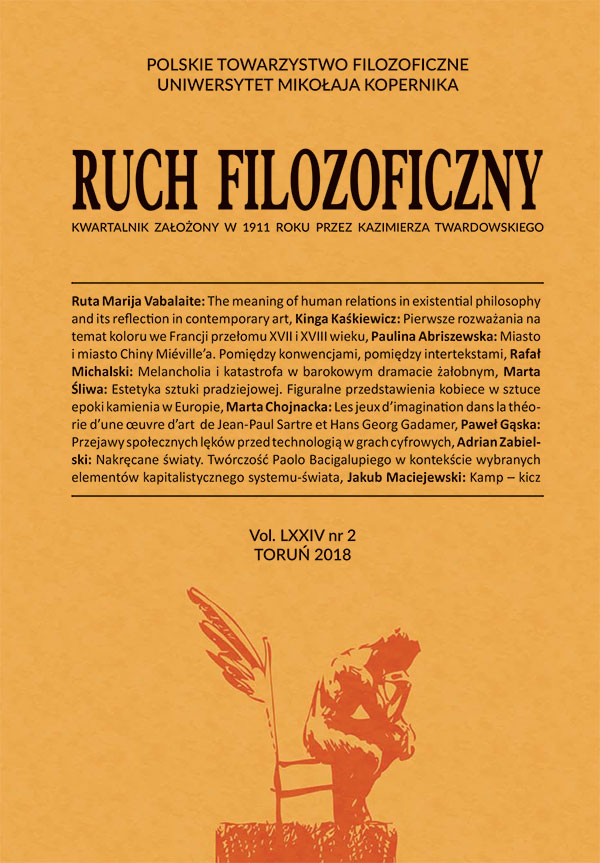The Meaning of Human Relations in Existential Philosophy and Its Reflection in Contemporary Art
DOI:
https://doi.org/10.12775/RF.2018.010Keywords
being-together, communication, loving struggle, community art, relational art, existential experienceAbstract
The features of human intercourse in contemporary consumerist society are at the centre of philosophical thought on personal existence; therefore, the first part of this article deals with the concepts of human relations in most distinctive existentialisms, i.e., Jacques Maritain’s Christian existentialism, Karl Jaspers and Albert Camus’s laic philosophies. The philosophical thought on alienation, consumerist attitude to others and even oneself is reflected in a lot of contemporary art movements as well. The creation of art is reconsidered as thematization of a lack of human inward and intimate touch, as relationist activity, as an involvement of publics into the communication and joint search for new existential experiences, for changes in our understanding of ourselves and of the world around us (Participatory art, some works of Transgressive art and Transhumanist art). There are art movements especially commissioned to reinstate of confidence, mobilize of coherence in transforming crisis. The engagement in community art practices helps a person to break the continuity of the flow of suspiciousness, hostility, and despair as well as to regain awareness in the meaningfulness of being together.
References
Barthes Roland, The Pleasure of the Text, Hill and Wang, New York 1998.
Bourriaud Nicolas, Relational Aesthetics, Les presses du réel, Paris 2002.
Camus Albert, The Rebel: an Essay on “Man in Revolt”, Vintage Books, New York 1958.
Camus Albert, The Myth of Sisyphus and other Essays, Vintage Books, New York 1991.
Camus Albert, The Plague, Penguin Books, Harmondsworth 1963.
Crowther Paul, On Why We Need Art – The Aesthetics of Self-Becoming, 2015. Retrieved on 25.05.2017. http://www.academia.edu/13714594/On_Why_ We_Need_Art_-_The_Aesthetics_of_Self-Becoming
Elsaesser Thomas and Hagener Malte, Film Theory: An Introduction through the Senses, Routledge, New York 2015.
Giunta Andrea, “Activism” in Contemporary art: 1989 to the present, ed. by Alexander Dumbadze and Suzanne Hudson, Wiley-Blackwell, Chichester, Malden (Mass.) 2013, p. 234–244.
Jaspers Karl, Der Philosophische Glaube, R. Piper & Co., München 1948.
Jaspers Karl, Philosophie, Springer, Berlin 1948.
Jaspers Karl, On my Philosophy, in: Existentialism from Dostoyevsky to Sartre, ed. by Walter Kaufman, Meridian Books, Inc., New York 1960.
Jaspers Karl, Way to Wisdom: An Introduction to Philosophy, Yale University Press, New Haven and London 1964.
Jaspers Karl, Philosophy of Existence, University of Pennsylvania Press, Philadelphia 1971.
Jaspers Karl, Man in the Modern Age, Routledge, Abington, New York 2010.
Jaspers Karl, Truth, Freedom, and Peace, “Existenz: An International Journal in Philosophy, Religion, Politics, and the Arts”, Vol. 9, 2014, No. 2, p. 1–12.
Knill Paolo J., Communal Art-making and Conflict Transformation, in: Art in Action. Expressive Arts Therapy and Social Change, eds. Levine Ellen G., Levine Stephen K., Jessica Kingsley Publishers, London and Philadelphia 2012, p. 53–77.
Levine Stephen K., Art Opens to the World: Expressive Arts and Social Action, in: Art in Action. Expressive Arts Therapy and Social Change, eds. Levine Ellen G., Levine Stephen K., Jessica Kingsley Publishers, London and Philadelphia 2012, p. 21–30.
Maritain Jacques, Truth and Human Fellowship, Princeton University Press, Princeton 1957.
Maritain Jacques, Art and Scholasticism, translated by Joseph W. Evans, 1962. Retrieved on 10.05.2017. http://maritain.nd.edu/jmc/etext/art.htm
Sloterdijk Peter, In the World Interior of Capital: for a Philosophical Theory of Globalization, Polity Press, Cambridge 2013.
Downloads
Published
How to Cite
Issue
Section
Stats
Number of views and downloads: 802
Number of citations: 0



